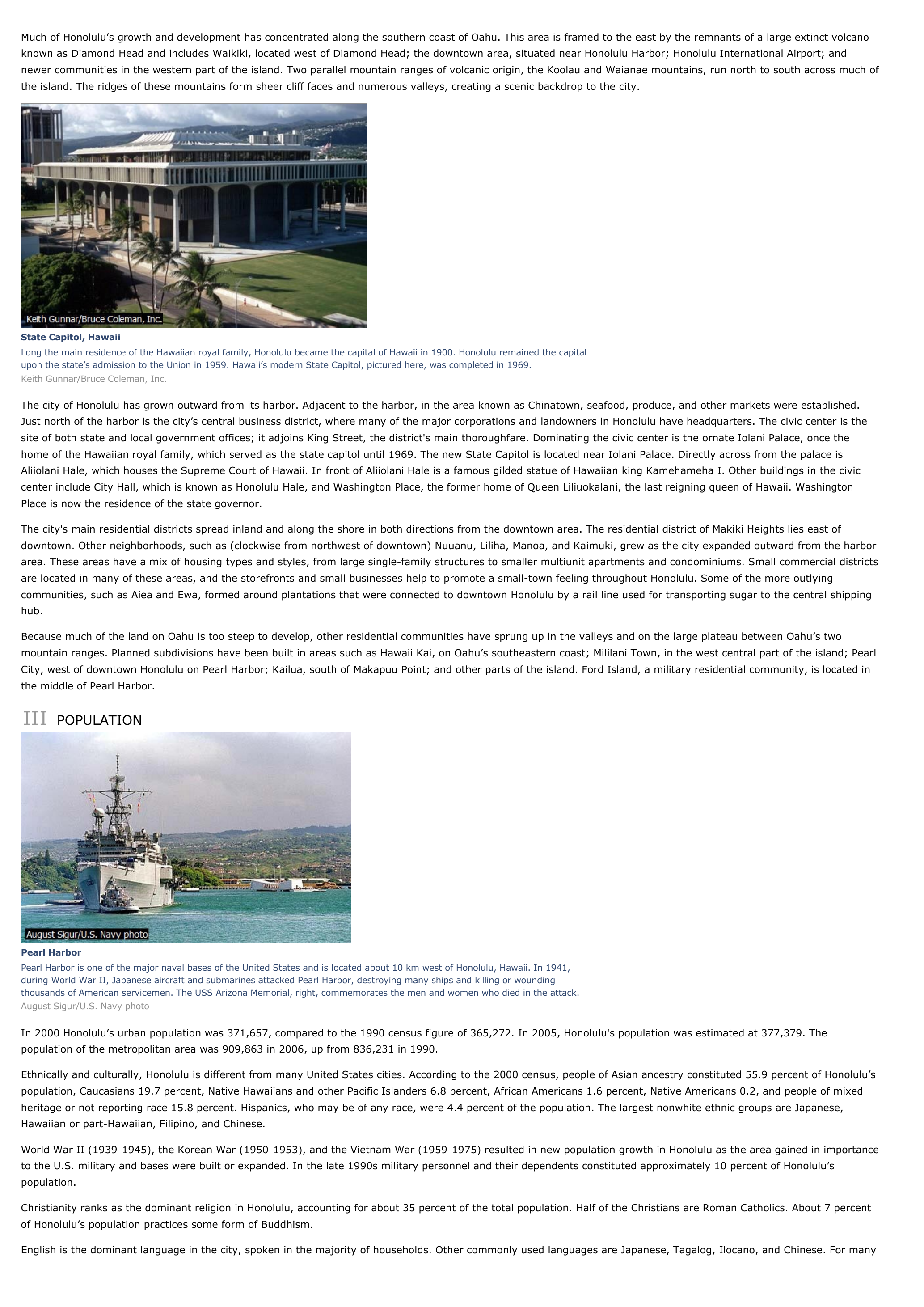Honolulu - geography.
Publié le 27/05/2013

Extrait du document
«
Much of Honolulu’s growth and development has concentrated along the southern coast of Oahu.
This area is framed to the east by the remnants of a large extinct volcanoknown as Diamond Head and includes Waikiki, located west of Diamond Head; the downtown area, situated near Honolulu Harbor; Honolulu International Airport; andnewer communities in the western part of the island.
Two parallel mountain ranges of volcanic origin, the Koolau and Waianae mountains, run north to south across much ofthe island.
The ridges of these mountains form sheer cliff faces and numerous valleys, creating a scenic backdrop to the city.
State Capitol, HawaiiLong the main residence of the Hawaiian royal family, Honolulu became the capital of Hawaii in 1900.
Honolulu remained the capitalupon the state’s admission to the Union in 1959.
Hawaii’s modern State Capitol, pictured here, was completed in 1969.Keith Gunnar/Bruce Coleman, Inc.
The city of Honolulu has grown outward from its harbor.
Adjacent to the harbor, in the area known as Chinatown, seafood, produce, and other markets were established.Just north of the harbor is the city’s central business district, where many of the major corporations and landowners in Honolulu have headquarters.
The civic center is thesite of both state and local government offices; it adjoins King Street, the district's main thoroughfare.
Dominating the civic center is the ornate Iolani Palace, once thehome of the Hawaiian royal family, which served as the state capitol until 1969.
The new State Capitol is located near Iolani Palace.
Directly across from the palace isAliiolani Hale, which houses the Supreme Court of Hawaii.
In front of Aliiolani Hale is a famous gilded statue of Hawaiian king Kamehameha I.
Other buildings in the civiccenter include City Hall, which is known as Honolulu Hale, and Washington Place, the former home of Queen Liliuokalani, the last reigning queen of Hawaii.
WashingtonPlace is now the residence of the state governor.
The city's main residential districts spread inland and along the shore in both directions from the downtown area.
The residential district of Makiki Heights lies east ofdowntown.
Other neighborhoods, such as (clockwise from northwest of downtown) Nuuanu, Liliha, Manoa, and Kaimuki, grew as the city expanded outward from the harborarea.
These areas have a mix of housing types and styles, from large single-family structures to smaller multiunit apartments and condominiums.
Small commercial districtsare located in many of these areas, and the storefronts and small businesses help to promote a small-town feeling throughout Honolulu.
Some of the more outlyingcommunities, such as Aiea and Ewa, formed around plantations that were connected to downtown Honolulu by a rail line used for transporting sugar to the central shippinghub.
Because much of the land on Oahu is too steep to develop, other residential communities have sprung up in the valleys and on the large plateau between Oahu’s twomountain ranges.
Planned subdivisions have been built in areas such as Hawaii Kai, on Oahu’s southeastern coast; Mililani Town, in the west central part of the island; PearlCity, west of downtown Honolulu on Pearl Harbor; Kailua, south of Makapuu Point; and other parts of the island.
Ford Island, a military residential community, is located inthe middle of Pearl Harbor.
III POPULATION
Pearl HarborPearl Harbor is one of the major naval bases of the United States and is located about 10 km west of Honolulu, Hawaii.
In 1941,during World War II, Japanese aircraft and submarines attacked Pearl Harbor, destroying many ships and killing or woundingthousands of American servicemen.
The USS Arizona Memorial, right, commemorates the men and women who died in the attack.August Sigur/U.S.
Navy photo
In 2000 Honolulu’s urban population was 371,657, compared to the 1990 census figure of 365,272.
In 2005, Honolulu's population was estimated at 377,379.
Thepopulation of the metropolitan area was 909,863 in 2006, up from 836,231 in 1990.
Ethnically and culturally, Honolulu is different from many United States cities.
According to the 2000 census, people of Asian ancestry constituted 55.9 percent of Honolulu’spopulation, Caucasians 19.7 percent, Native Hawaiians and other Pacific Islanders 6.8 percent, African Americans 1.6 percent, Native Americans 0.2, and people of mixedheritage or not reporting race 15.8 percent.
Hispanics, who may be of any race, were 4.4 percent of the population.
The largest nonwhite ethnic groups are Japanese,Hawaiian or part-Hawaiian, Filipino, and Chinese.
World War II (1939-1945), the Korean War (1950-1953), and the Vietnam War (1959-1975) resulted in new population growth in Honolulu as the area gained in importanceto the U.S.
military and bases were built or expanded.
In the late 1990s military personnel and their dependents constituted approximately 10 percent of Honolulu’spopulation.
Christianity ranks as the dominant religion in Honolulu, accounting for about 35 percent of the total population.
Half of the Christians are Roman Catholics.
About 7 percentof Honolulu’s population practices some form of Buddhism.
English is the dominant language in the city, spoken in the majority of households.
Other commonly used languages are Japanese, Tagalog, Ilocano, and Chinese.
For many.
»
↓↓↓ APERÇU DU DOCUMENT ↓↓↓
Liens utiles
- Honolulu - geography.
- Tokyo - geography.
- Toronto - geography.
- Venice (Italy) - geography.
- Vienna - geography.

































